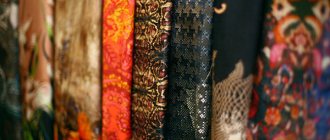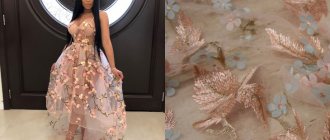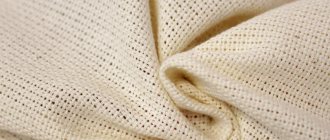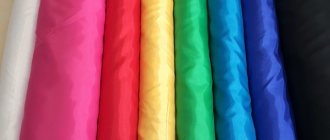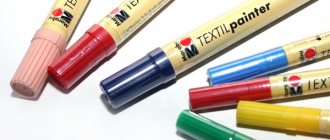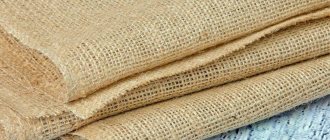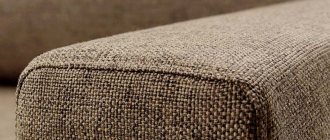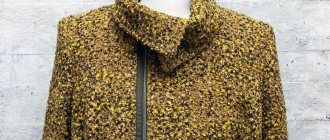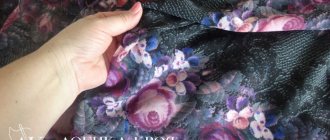The basis of the wardrobe is the dress. It emphasizes femininity, the dignity of the figure, creates comfort and decorates. Depending on the style, color and type, they wear it to work, walk, attend parties and special events.
Dress fabrics represent a group of materials that combine dense and light materials, warm and summery, flowing and shape-holding, natural and synthetic, for different occasions and seasons. The presented types of fabrics for dresses consist of natural and synthetic fibers, with and without stretch, with a decorative and matte surface, everyday, elegant and universal. A description of the properties and features of the fabric will help you make the right choice.
Flowing dense
Barbie
Barbie is a costume material for business wear. Characterized by softness and elasticity due to stretch fibers. The texture of the fabric is rough, dense and soft to the touch. The matte material is pleasant and comfortable to wear. It has a synthetic composition of polyester, viscose and spandex with the addition of elastane. Barbie fabric can be plain or patterned.
Crepe suit
A popular fabric for everyday and formal wear, as well as sheath dresses. It has a presentable appearance and positive performance characteristics. The fabric is dense, with the inherent crepe grain. Minimal give ensures good fit and comfortable wear. The fabric does not stretch and does not interfere with freedom of movement. Mostly a plain crepe suit is produced. Patterns and prints are less common. The composition includes natural and synthetic fibers: cotton, wool, polyester, acrylic and viscose.
Stretch velor
Stretch velor is a luxurious material. The material has a soft, fleecy surface with a sparkling shine. The dense structure of the fabric acquires elasticity due to stretch fibers. The material is pleasant to the touch and comfortable to wear. Gracefully fits the figure. It is presented on the market in a plain-painted version in a palette of shades. Suitable for evening and ball gowns, skirts and knee socks.
Gabardine
Gabardine is a dense, light and soft fabric that is resistant to deformation. Lacks elasticity except for the stretch version. It turns out to be a twill weave, which leaves a diagonal scar on the matte surface. The material is double-sided.
Available in wool gabardine, blended, cotton, silk, stretch and synthetic. Pleasant to wear and practical, the material is made in plain colors, checkered, or printed.
Office Style
Plainly dyed fabrics in calm shades are suitable.
For demi-season models, choose wool or wool blend (with the addition of lavsan, viscose, nylon fibers, elastane).
For summer dresses, mixed twill, linen and semi-linen materials are used. The tight-fitting silhouette of the office dress suggests the presence of stretch (elastane content 2–7%). This is a necessary condition for correct fit to the figure.
Wool and wool mixtures are conventionally divided into 2 groups:
- with visible thread weaving (Boston, gabardine);
- thin with a fleecy cover (tweed).
Lungs
Oil
The fabric belongs to modern knitted fabrics with a characteristic soft-oily structure. Made from viscose, lycra and polyester fibers in several combinations. The oil material is dense and flexible, elastically stretches in different directions and fits the figure well. Silky material can have a matte or glossy surface. The oil is comfortable to wear, has breathable properties and looks attractive.
Niagara
Refers to dress, flowing fabrics. Despite its fine structure, niagara is not translucent. It has a matte, smooth surface, pleasant to the touch. It stretches across the transverse thread, across the width of the fabric. It is made from viscose and polyester fibers with a plain or printed pattern. Does not wrinkle and drapes gracefully. Looks light and airy.
Poplin
Cotton-based material with the addition of polyester, silk or wool fibers. Produced with printed, variegated or smooth patterns. Poplin is soft and pleasant to wear. Provides air access to the skin and moisture absorption. Retains color saturation for a long time and does not wrinkle. Comfortable clothes for everyday wear are sewn from it.
Silk Armani
Modern material for a summer or elegant dress. Attracts with its silky surface with a matte shine. Consists of polyester fibers with a small addition of spandex (3%). The thin, slippery Armani silk fabric is made from satin weave and resembles silk. It has elasticity and wear resistance. Has low hygroscopicity and breathability. Requires the use of an antistatic agent. Looks impressive in models of dresses, skirts and loose-fitting blouses, with folds and draperies.
Chiffon
Very light, thin, transparent and airy chiffon has a matte surface and a sandy structure. Consists of natural silk or synthetic fibers. Externally, the fabric is quite durable. There are many varieties available: nylon, chiffon-satin, jacquard, with lurex, chameleon and shanzhan.
Used alone or in combination with companion fabrics. The ability flows softly, giving the image femininity and mystery.
Atlas
Satin is a smooth, silky material with a luxurious, glossy surface that shines and shimmers. Made from silk, cotton, synthetic, viscose and nylon fibers. It can be plain or with bright patterns applied with embroidery, embossing, and printing. The fabric is durable and wear-resistant, does not fade, is comfortable, and is suitable for draperies. Used for evening and wedding dresses, elegant clothes.
Crepe de Chine
The lightweight fabric has a matte sheen and a rough, wavy structure. Crepe de Chine is soft and pleasant to the skin. Smoothly follows the curves of the figure and forms graceful folds. Durable and comfortable to wear. Available in a wide palette of shades, patterns and prints as shown in the photo. Allows you to realize your fantasies in creating feminine silhouettes.
Staple
Soft and delicate fabric, elastic and easily takes the desired shape of the dress style. The silky, smooth surface, as well as the variety of colors, patterns and designs guarantee a luxurious look to the outfit. At the same time, it will be comfortable in the heat. Staple fabric is a natural material that includes viscose or cotton.
Georgette
Thin, twisted threads produce a translucent material. Georgette has a matte surface and a grainy, harsh texture. It is elastic and pliable, shape-resistant and effective. The material can be plain, with a printed pattern, designer trim, or sparkles. The fibers used for production are silk, polyester, viscose, cotton, and elastane.
Silk
The name of fabrics for royal dresses, luxurious and refined. It has a soft shine with shimmer, smoothness and lightness. Many types of silk fabrics are made, differing in structure, quality of threads, and appearance. They are all durable and extremely comfortable to wear. In textile production, silk is made from artificial fibers viscose and nylon, but nothing compares to natural silk, made from non-mulberry cocoons.
What to sew from
The selection criteria described above can tell you what to make clothes from. Yet the choice of material often depends on its purpose and time of year. The three main groups of outfits and the materials used to sew them are described below.
Summer outfits
Fabrics for summer dresses are selected in accordance with the needs of the body. They should be light and breathable. Natural materials must be used in their production. Dresses made from natural fabrics bring less inconvenience and can be worn longer. When choosing what fabric to make a summer dress from for everyday wear, you should think about the hygienic properties of the materials.
Recommended summer fabric names:
- lace;
- atlas;
- viscose;
- linen;
- polyester;
- silk;
- chiffon;
- cotton;
- chintz.
It is necessary to choose dresses, both everyday and evening, that suit the weather, but at the same time look feminine and do not restrict movement. What to look for when choosing fabric for summer clothing:
- hypoallergenic;
- the ability to accumulate static electricity;
- drying time;
- ability to absorb moisture;
- Does the material wrinkle a lot?
Knowing how to correctly cut a transformable dress on fabric, you can easily make a summer outfit from knitted fabric in the shortest possible time at home.
Lace
Atlas
Viscose
Linen
Polyester
Silk
Chiffon
Cotton
Chintz
Evening dresses
There are quite a lot of materials that are called for dresses intended for special occasions. These include:
- chiffon;
- lace;
- brocade;
- atlas;
- taffeta;
- crepe georgette;
- jacquard and others.
The material should be selected based on the following parameters:
- the ability of matter to wrinkle;
- the ability of the material to flow;
- number of layers of the skirt;
- proposed decor and decorations;
- purpose of the outfit;
- whether we sew a cover for the dress or not (the fit of the outfits in such cases is different);
- proposed materials for combination with the main one.
Knowing how to calculate the amount of fabric is especially necessary if you need to sew a dress from pleated fabric that has a multi-layered skirt or an outfit made from different materials. Cutting out an evening dress is quite difficult, especially if 3D printed fabrics are used. In this case, you should cut the material according to the large drawing. It is possible to calculate how much fabric will be spent on a dress made of linen with a large pattern only by assessing the pattern.
Chiffon
Lace
Brocade
Atlas
Taffeta
Crepe georgette
Jacquard
Warm models
The best fabrics for creating warm dresses are the following:
- angora;
- gabardine;
- polyamide;
- tartan and others.
Some dresses use crochet to create decorative details, peplums or ruffles. The hem in warm dresses can be created from distinctive materials that were not used in the manufacture of the main part of the outfit. The combination of materials is most suitable when making a belt, sleeves, and neckline.
For warm dresses, instead of a zigzag stitch, you can use a hook to decorate the edge. The tied edge will be compacted and the material will not fray. Using warm wool for knitting will make the dress more formal, exclusive and expensive.
Eco-leather is especially popular when sewing warm models. Leather belts, and sometimes entire parts of the dress, such as sleeves, make the outfit more formal and festive. Such inserts indicate the good taste of the girl who wears this outfit.
As the material described above shows, the choice of models for making clothing should be approached responsibly. The quality of the fabric, print and pattern determines much of the success of the finished garment. You can select the right material without consulting specialists. Still, if a suit is made with the participation of professional designers or seamstresses, you should listen to their opinion, since they have extensive experience in making formal and everyday outfits.
Angora
Gabardine
Polyamide
Plaid
Dense and hold their shape
Taffeta
Taffeta is an elegant fabric with a noble, glossy shine. Properties allow you to create creases and give a curvy shape. Taffeta is hard to the touch and does not allow light to pass through. Can be: silk, viscose, cotton or polyester. It is painted in one color or with a chameleon effect, when the shade changes depending on the lighting and smoothly flows from one to another. Taffeta is used to create evening and wedding dresses, exquisite dresses and luxurious skirts.
Neoprene
New foam rubber material covered with elastic fabric made of polyester, cotton or mixed fibers. It is light, soft, flexible and plastic. It varies in density and thickness, but is always durable. It has heat-saving and waterproof properties. Resistant to external influences, does not wrinkle and is safe for the skin. Neoprene fabric is used to create trendy and designer clothing with clear lines and characteristic fluffiness.
Jeans
Comfortable and practical fabric is used for sewing stylish dresses, sundresses and skirts. Jeans can be not only the usual plain one, but with an original print, sequins, stretch, unbleached, chambray for summer clothes, or with embroidery and even brushed. In the classic version it is 100% cotton, but it is also possible with the addition of lycra and elastane.
Corset satin
Corset satin is a dense fabric with a matte and glossy side. The facial skin is silky, smooth, with a characteristic shine. The material is flexible and cool in contact with the skin. It is made in a monochromatic range in all the richness of shades. It is used in wedding, festive and evening dresses, where you need to emphasize the silhouette.
Linen
The name accurately conveys the properties and purpose of the fabric. Linen is obtained from natural plant fibers and is intended for hot days. Linen will provide comfort to wear, cool and protect from overheating. It is soft and light, with a smooth, matte surface and little shine. It has a high degree of strength and wear resistance. Painted in soft, natural tones. Suitable for sewing models with a loose silhouette and slightly fitted ones.
Fabric composition
According to the composition of the fabric there are:
- natural (linen, silk, wool, cotton);
- artificial (viscose);
- synthetic (polyamide, polyester, nylon);
- mixed (combination of natural and artificial threads).
Visually, you should like the fabric. It is chosen according to color scheme, print, tactile sensations. The fabric must match the style and purpose of the dress.
Lungs
Organza
Organza is a thin, transparent fabric with a rigid structure. It is obtained by tightly twisting the fibers of silk, polyester or viscose. Available with a matte or shiny, sparkling surface. Available in plain color or crinkled. The design or decoration is applied by embroidery, printing, etching, spraying. The fabric is durable and shape-resistant. Differs in light transmission. Organza is used to make evening and stage dresses and dance costumes.
Crepe satin
Crepe satin is a double-sided silk material. The front side is glossy and silky like satin, and the back side is matte-grained. The fabric is plain-dyed, less often with a printed pattern. It is often made from polyester, which is cheap, but is also found in fibers of silk, viscose, and silk acetate. Crepe-satin holds its shape due to its density and elasticity and does not wrinkle. Forms smooth, beautiful folds. Suitable for festive dresses and suits.
T.C.
Tisi is an example of a practical and high-quality fabric made from mixed fibers. Consists of viscose, polyester and cotton, positive properties that are successfully combined.
The fabric is strong and light, breathable and durable, does not wrinkle or tear when worn. Such clothes keep their shape and do not attract dust. It is made mainly plain-painted.

